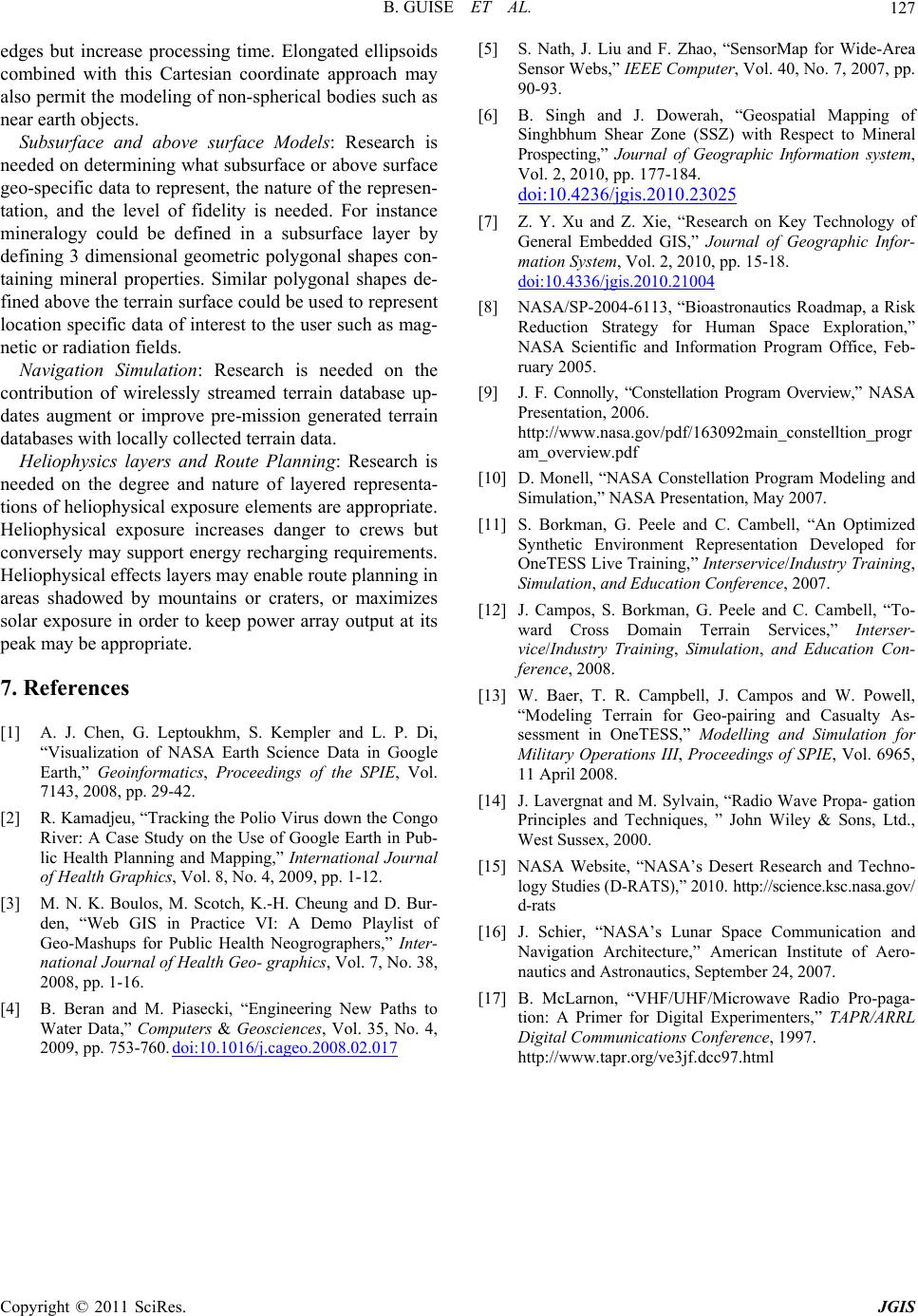
B. GUISE ET AL.
Copyright © 2011 SciRes. JGIS
127
edges but increase processing time. Elongated ellipsoids
combined with this Cartesian coordinate approach may
also permit the modeling of non-spherical bodies such as
near earth objects.
Subsurface and above surface Models: Research is
needed on determining what subsurface or above surface
geo-specific data to represent, the nature of the represen-
tation, and the level of fidelity is needed. For instance
mineralogy could be defined in a subsurface layer by
defining 3 dimensional geometric polygonal shapes con-
taining mineral properties. Similar polygonal shapes de-
fined above the terrain surface could be used to represent
location specific data of interest to the user such as mag-
netic or radiation fields.
Navigation Simulation: Research is needed on the
contribution of wirelessly streamed terrain database up-
dates augment or improve pre-mission generated terrain
databases with locally collected terrain data.
Heliophysics layers and Route Planning: Research is
needed on the degree and nature of layered representa-
tions of heliophysical exposure elements are appropriate.
Heliophysical exposure increases danger to crews but
conversely may support energy recharging requirements.
Heliophysical effects layers may enable route planning in
areas shadowed by mountains or craters, or maximizes
solar exposure in order to keep power array output at its
peak may be appropriate.
7. References
[1] A. J. Chen, G. Leptoukhm, S. Kempler and L. P. Di,
“Visualization of NASA Earth Science Data in Google
Earth,” Geoinformatics, Proceedings of the SPIE, Vol.
7143, 2008, pp. 29-42.
[2] R. Kamadjeu, “Tracking the Polio Virus down the Congo
River: A Case Study on the Use of Google Earth in Pub-
lic Health Planning and Mapping,” International Journal
of Health Graphics, Vol. 8, No. 4, 2009, pp. 1-12.
[3] M. N. K. Boulos, M. Scotch, K.-H. Cheung and D. Bur-
den, “Web GIS in Practice VI: A Demo Playlist of
Geo-Mashups for Public Health Neogrographers,” Inter-
national Journal of Health Geo- graphics, Vol. 7, No. 38,
2008, pp. 1-16.
[4] B. Beran and M. Piasecki, “Engineering New Paths to
Water Data,” Computers & Geosciences, Vol. 35, No. 4,
2009, pp. 753-760. doi:10.1016/j.cageo.2008.02.017
[5] S. Nath, J. Liu and F. Zhao, “SensorMap for Wide-Area
Sensor Webs,” IEEE Computer, Vol. 40, No. 7, 2007, pp.
90-93.
[6] B. Singh and J. Dowerah, “Geospatial Mapping of
Singhbhum Shear Zone (SSZ) with Respect to Mineral
Prospecting,” Journal of Geographic Information system,
Vol. 2, 2010, pp. 177-184.
doi:10.4236 /jgis.2010.23025
[7] Z. Y. Xu and Z. Xie, “Research on Key Technology of
General Embedded GIS,” Journal of Geographic Infor-
mation System, Vol. 2, 2010, pp. 15-18.
doi:10.4336/jgis.2010.21004
[8] NASA/SP-2004-6113, “Bioastronautics Roadmap, a Risk
Reduction Strategy for Human Space Exploration,”
NASA Scientific and Information Program Office, Feb-
ruary 2005.
[9] J. F. Connolly, “Constellation Program Overview,” NASA
Presentation, 2006.
http://www.nasa.gov/pdf/163092main_constelltion_progr
am_overview.pdf
[10] D. Monell, “NASA Constellation Program Modeling and
Simulation,” NASA Presentation, May 2007.
[11] S. Borkman, G. Peele and C. Cambell, “An Optimized
Synthetic Environment Representation Developed for
OneTESS Live Training,” Interservice/Industry Training,
Simulation, and Education Conference, 2007.
[12] J. Campos, S. Borkman, G. Peele and C. Cambell, “To-
ward Cross Domain Terrain Services,” Interser-
vice/Industry Training, Simulation, and Education Con-
ference, 2008.
[13] W. Baer, T. R. Campbell, J. Campos and W. Powell,
“Modeling Terrain for Geo-pairing and Casualty As-
sessment in OneTESS,” Modelling and Simulation for
Military Operations III, Proceedings of SPIE, Vol. 6965,
11 April 2008.
[14] J. Lavergnat and M. Sylvain, “Radio Wave Propa- gation
Principles and Techniques, ” John Wiley & Sons, Ltd.,
West Sussex, 2000.
[15] NASA Website, “NASA’s Desert Research and Techno-
logy Studies (D-RATS),” 2010.
http://science.ksc.nasa.gov/
d-rats
[16] J. Schier, “NASA’s Lunar Space Communication and
Navigation Architecture,” American Institute of Aero-
nautics and Astronautics, September 24, 2007.
[17] B. McLarnon, “VHF/UHF/Microwave Radio Pro-paga-
tion: A Primer for Digital Experimenters,” TAPR/ARRL
Digital Communications Conference, 1997.
http://www.tapr.org/ve3jf.dcc97.html